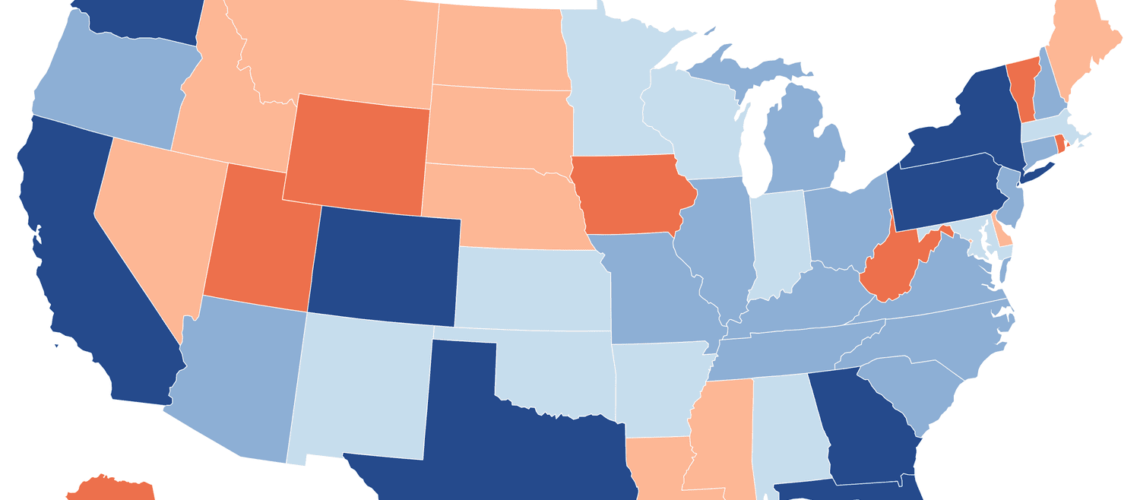Today’s Mortgage Rates by State – Dec. 17, 2024
December 17, 2024

- Ferrovial Extends Buyback While Sabadell Repays Mortgage Bonds Early
- Here’s when homeowners should give up their low mortgage rate to buy a new home, according to experts
- Will interest rates keep trending up into 2025?
- Mortgage delinquencies deteriorate in November
- Prepare for a wild ride in 2025, Fannie Mae warns
The states with the cheapest 30-year new purchase mortgage rates Monday were New York, California, Florida, Washington, Texas, Colorado, Georgia, and Pennsylvania. The eight states registered averages between 6.65% and 6.75%.
Meanwhile, the states with the highest Monday averages were Alaska, Rhode Island, West Virginia, Wyoming, Iowa, Utah, and Vermont. The range of 30-year averages for these states was 6.86% to 6.91%.
Mortgage rates vary by the state where they originate. Different lenders operate in different regions, and rates can be influenced by state-level variations in credit score, average loan size, and regulations. Lenders also have varying risk management strategies that influence the rates they offer.
Xem thêm : Mortgage Rates Hit 6.91%, Highest Since July, But Buyers Return Despite Costs
Since rates vary widely across lenders, it’s always smart to shop around for your best mortgage option and compare rates regularly, no matter the type of home loan you seek.
The rates we publish won’t compare directly with teaser rates you see advertised online since those rates are cherry-picked as the most attractive vs. the averages you see here. Teaser rates may involve paying points in advance or may be based on a hypothetical borrower with an ultra-high credit score or for a smaller-than-typical loan. The rate you ultimately secure will be based on factors like your credit score, income, and more, so it can vary from the averages you see here.
National Mortgage Rate Averages
Rates on 30-year new purchase mortgages ticked up a single basis point Monday, to a 6.78% average. That’s a fifth rising day after last week sinking to a 7-week low. In September, 30-year rates plunged to 5.89%—the cheapest average in two years—but they then surged higher. While currently still elevated, 30-year mortgage rates remain below where they were this summer, when they started July above 7%.
| National Averages of Lenders’ Best Mortgage Rates | |
|---|---|
| Loan Type | New Purchase |
| 30-Year Fixed | 6.78% |
| FHA 30-Year Fixed | 6.28% |
| 15-Year Fixed | 5.94% |
| Jumbo 30-Year Fixed | 6.72% |
| 5/6 ARM | 7.34% |
| Provided via the Zillow Mortgage API | |
Calculate monthly payments for different loan scenarios with our Mortgage Calculator.
What Causes Mortgage Rates to Rise or Fall?
Mortgage rates are determined by a complex interaction of macroeconomic and industry factors, such as:
Because any number of these can cause fluctuations simultaneously, it’s generally difficult to attribute any change to any one factor.
Macroeconomic factors kept the mortgage market relatively low for much of 2021. In particular, the Federal Reserve had been buying billions of dollars of bonds in response to the pandemic’s economic pressures. This bond-buying policy is a major influencer of mortgage rates.
But starting in November 2021, the Fed began tapering its bond purchases downward, making sizable monthly reductions until reaching net zero in March 2022.
Between that time and July 2023, the Fed aggressively raised the federal funds rate to fight decades-high inflation. While the fed funds rate can influence mortgage rates, it doesn’t directly do so. In fact, the fed funds rate and mortgage rates can move in opposite directions.
But given the historic speed and magnitude of the Fed’s 2022 and 2023 rate increases—raising the benchmark rate 5.25 percentage points over 16 months—even the indirect influence of the fed funds rate has resulted in a dramatic upward impact on mortgage rates over the last two years.
The Fed maintained the federal funds rate at its peak level for almost 14 months, beginning in July 2023. But on Sept. 18, the central bank announced the first rate cut in what’s expected to be a series of decreases in 2024 and likely 2025. This first reduction was by 0.50 percentage points.
On Nov. 7, the Fed announced an additional rate cut of 0.25 percentage points, bringing the federal funds rate to 4.5% to 4.75%. With this cut, the fed funds rate reaches its lowest level since March 2023.
The Fed’s next rate announcement will be made Dec. 18.
How We Track Mortgage Rates
The national and state averages cited above are provided as is via the Zillow Mortgage API, assuming a loan-to-value (LTV) ratio of 80% (i.e., a down payment of at least 20%) and an applicant credit score in the 680–739 range. The resulting rates represent what borrowers should expect when receiving quotes from lenders based on their qualifications, which may vary from advertised teaser rates. © Zillow, Inc., 2024. Use is subject to the Zillow Terms of Use.
Nguồn: https://modusoperandi.my
Danh mục: News
